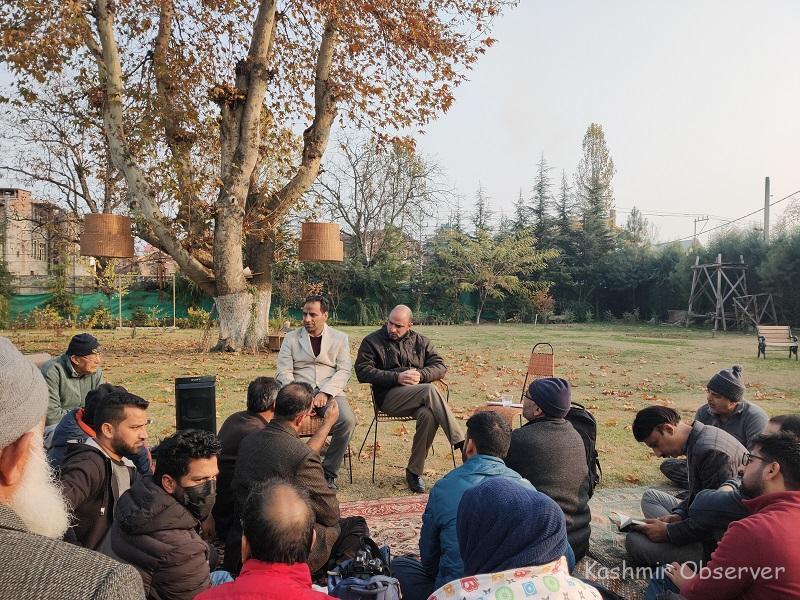
Talk On 'Persian Literary Traditions Of Kashmir' Held
KO Photos By Syed Mohammad Burhan
Srinagar- A talk on Persian literary traditions of Kashmir was held at Kani home, Zakura on Sunday afternoon. The talk was delivered by Prof. Mufti Mudasir Farooqi who is a faculty member at the department of English, University of Kashmir. The event which was held in the lawns of Kani home was attended by a wide range of literary personalities.
Speaking on the occasion, Professor Mufti Mudasir said the beginnings of Persian language in Kashmir can be traced back to 14th century A.D. with the establishment of Shahmiri rule.
“The influx of missionaries and Sufis who came to Kashmir from Persia, primarily, for the spread of Islam in the region are important aspects responsible for the establishment of Persian language. Most of the religious literature was in Persian,” Mufti said.
When Amir-e-Kabir Mir Syed Ali Hamdani (RA) during the reign of Sultan Qutb-ud-din came here, he came along with 700 people who were very well versed with a lot of things and spoke Persian which gave impetus to the language.
Allama Iqbal calls Mir Syed Ali Hamdani Seyyedus Sadaat Salaar-e-ajam
Daste ou maemaare taqdeer-e-Ummam
“His hands were the architects of the destiny of nations”
Thereafter, Persian flourished in Kashmir” he said.
Prof Mufti said that broadly speaking in terms of Kashmir, history we can identify certain traditions like tareekh tradition, tazkira tradition, poetic tradition, theological traditions, although all these overlap but these can be seen as literary traditions in the larger context.
Mufti said the most important of them was the tazkira tradition. Tazkiras are hagiographies where someone decides to write about the lives of saints and is not particular to any religion.
“When writers started to write things in Persian they started to record these lives belonging to different orders soharvarhis and kubarvis”
“However, hagiographies should not be seen as objective histories. Those who have written these hagiographies have projected it as the embodiments of virtue”
In some hagiographies Rishis and Sufis have been put in the same framework. For example in the case of Mir Mohammad Hamdani and Sheikh ul Aalam which led to Mir Mohammad Hamdani giving him Khat ul Irshad, which is in Arabic and at present is at Khanqah-e-Moula.
Meaning that Sufi of a qubravi order is now permitting a Kashmiri rishi to take disciples in that Order (silsila).
The anxiety which was there regarding the 'unislamic' nature of 'rishis' was overcome in this manner.
He noted that Power has always played a role and in Kashmir Persian was a language of power. It was the language of court and administration. It became a language in which poets and theologists.
The tareekh writing is seen as a very conscious effort by historians (morikhs) as an act that can be conceived in the framework of Islam.
“They begin with invoking God's name and Kashmir has special place, it is place where Islam is meant to flourish”
Tareekhs have a lot to say about those times and eminent people those days were rulers or saints.
During the chakh period we have a Persian poet Sheikh Yaqoob e Sarfvi who was a versatile genius, a poet and a jurist and among his works is panjgung which was written in the imitation of nizami and also a dewan of ghalas and rubiaat.
“Sarfi and Hubbi are the important poets of the Chakh period and a genuine lover of Ahlulbait (a.s)” he said.
As far as the Mughal period is concerned, it turned out to be the golden period for Persian poetry. Influx of poets from Iran to India began. They looked for a place near Iran, so they came to India.
Gani Kashmiri has a name in sabk e hindi and has surprising among other things written about the harshness of winter.
During those times many poets called Kashmir home: Kaleem Kashani, Toghra Mashhadi, Saleem Tehrani, Mir Elahi.
And many Kashmiri poets were born during the Mughal period, Mirza Darab Joya, Mirza Akmaluddin Kamil and Mohammad Aslam Salim.
Afghan period starts in 1753 upto 1819 and then Sikh period from 1819 to 1846.
The Afghan and Sikh periods are known for their oppression but poetry continued in the form of masnavis during the Afghan period.
Abdul Wahab Shaiq is one the poets who wrote Shahnama-e-Kashmir and is based on 60,000 verses and Mulla Taufeeq continued it. Mulla Shahabadi is another important poet who saw both Afghan and Sikh rule and two years of Dogra rule.
With the coming of Dogras Persian started to lose its eminence.
Mufti further defined Persian as a cosmopolitan language which spread from Ottomans in Turkey to Mughals in India and in the midst of all this, Kashmiris got an opportunity to make use of that.
He said for the revival of the language, there is no other way than to learn the language.
Among those who attended the event were Ghulam Nabi Sheikh Ladakhi, writer and former IAS officer, Author and columnist Mohammad Maruf shah, Rashid Aziz, Faculty Dept. of Urdu, Kashmir University, Prof Altaf Anjum Dept. of Distance Education Kashmir University and activist Ishaq Nehvi. The event was moderated by Faizan Bhat.
follow this link to join our whatsapp group : join now

Legal Disclaimer:
MENAFN provides the
information “as is” without warranty of any kind. We do not accept
any responsibility or liability for the accuracy, content, images,
videos, licenses, completeness, legality, or reliability of the information
contained in this article. If you have any complaints or copyright
issues related to this article, kindly contact the provider above.






















Comments
No comment